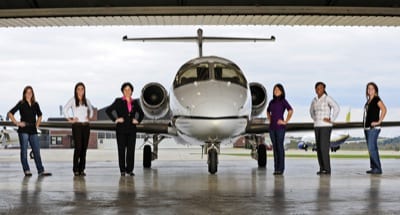
Amelia Earhart continues to inspire Purdue University students today just as she did more than 70 years ago when she coached young women about careers and flew above campus with the plane that would eventually disappear with her over the Pacific Ocean.
“Before Amelia Earhart climbed in the cockpit and captured the world’s attention when she embarked on her flight around the world, the famous aviatrix was inspiring hundreds of Purdue students to pursue their dreams and careers,” said Purdue President France Córdova. “She continues to captivate millions, and interest in her has been renewed because of the movie opening this month.”
“Amelia,” starring Hillary Swank, opens Friday (Oct. 23). The biopic focuses on her life, specifically her career in aviation and relationship with George Palmer Putnam.
Purdue is home to the world’s largest compilation of Earhart-related papers, memorabilia and artifacts, which also is available online. The collection includes documents related to Earhart’s 1932 solo Atlantic flight, her second and fatal attempt at a world flight in 1937, and items related to her time at Purdue.
In April 1936 an Amelia Earhart Fund for Aeronautical Research was created with the Purdue Research Foundation. The fund purchased the $80,000 Lockheed Electra that became known as Earhart’s flying laboratory. With navigator Fred Noonan, Earhart disappeared July 2, 1937, near the tiny Howland Island in the Pacific Ocean while attempting an around-the-world voyage.
“Researchers, authors and fans from all over the world have contacted Purdue for information about Earhart,” said Sammie Morris, associate professor of library science and Purdue University archivist. “Of course, many focus on the mystery surrounding her disappearance, but scholars are finding that elements of her life are just as captivating.”
As head of the Division of Archives and Special Collections at Purdue University Libraries, Morris oversees the George Palmer Putnam Collection of Amelia Earhart Papers. Earhart’s prenuptial letter to Putnam is a favorite piece in the collection, as well as the flight log she kept for her 1932 solo flight across the Atlantic, Morris said. The collection has been digitized and placed online for sharing with the world and to protect fragile original documents and artifacts from repeated handling.
Earhart, who was a Purdue career counselor and adviser to the Department of Aeronautics from 1935-1937, was recruited by then-President Edward Elliott, who was impressed by her sprit of adventure and her message to women. “Yes, her passion was flight, but she was devoted to inspiring others to find their callings in life,” said Robin Jensen, an assistant professor of communication who studies Earhart. “She spent more time writing about her flights and what she hoped they meant for others than she ever spent in the sky.”
Earhart continues to have a presence on campus: a residence hall and a café in the Neil Armstrong Hall of Engineering both bear her name. A larger than life-size statue was dedicated in 2009 in her honor. In March 2010 key items from the Earhart collection will be on display in Archives and Special Collections as part of Women’s History Month.
For more information: Purdue.edu
